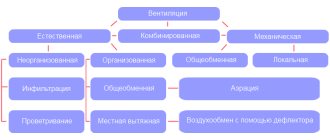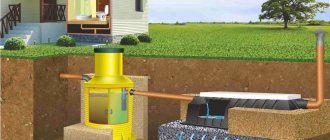Full life on a summer cottage is associated with the formation of a significant amount of household waste. If the house is not connected to the central sewer system, then the problem of water waste disposal will be solved by an autonomous drainage system. The three-section septic tank is an integral part of it. It represents an underground structure that purifies household water from dirt and bacteria.
Each of the three cameras performs its assigned function. At the output, the settled, clarified and maximally neutralized liquid is suitable for reuse - for watering plants and household needs.
Scheme of the device and principle of operation of the septic tank
When considering the design and principle of operation of the sump, it turns out that all treatment facilities have much in common.
Most autonomous sewage systems are combined containers for the gradual purification of waste and the production of sediment in the form of insoluble particles of various inclusions.
Tanks are made from various materials (reinforced concrete rings, car tires, bricks, flat slate). They are also made in different configurations.
Septic tank made of concrete rings
Three-chamber water purifiers constructed from reinforced concrete rings are also economical and popular. They solve the problem of accumulation, decomposition and processing of contaminated household wastewater by anaerobic bacteria no worse than plastic devices.
A three-section septic tank with an additional section, in addition to water storage tanks, is equipped with additional devices: a filter well, as well as another one in which the fermentation process takes place. All compartments are connected by overflow drains.
Principle of operation
The operating principle of a septic tank, equipped according to all the rules, is a complex scheme, as a result of which the negative impact on the soil and the environment is minimized. According to the traditional scheme, a septic tank is a treatment facility, and it looks like a device of two or three chambers. The first container is a storage facility for waste directly from the sewer line.
This is where the mixture decomposes. In the chamber, the wastewater breaks down under the action of bacteria into a sludgy substance and settled water.
IMPORTANT! The first tank should be of such a volume that it is enough for use for three days, during which the mass decomposes.
After the water has settled and purified a little, it flows into the second chamber - the filtration well. If the first container is made hermetically according to SNiP, then the second one must be made with a drainage bottom (crushed stone, gravel or sand). Water passes through the drainage, is filtered and absorbed into the ground, thereby not polluting it.
Scheme of a simple septic tank with soil-based wastewater treatment Source roomester.ru
Plastic septic tank
The three-section septic tank is a cylinder, inside of which there are cleaning chambers. The total volume of such a device depends on its modification: it ranges from one and a half to ten thousand liters. The three-section storage septic tank has a high throughput capacity - up to 750 liters of household liquid per day.
At dachas, devices made of polymer materials are often used to purify household water. A plastic container for a three-section water purifier is an inexpensive treatment facility. It can be in the form of a cylinder or a prism with additional stiffening ribs.
General operating principle:
- in the first compartment, small debris, organic, fat and oil suspensions present in the liquid precipitate;
- in the second section, its fermentation and clarification occurs;
- in the third chamber, the maximum purification of domestic wastewater is completed up to 90%.
For plastic settling tanks, propylene drains are selected.
Advantages and disadvantages of septic tanks
Depending on how the septic tank is designed, the family’s living conditions will radically improve, and this will be the main advantage of such a treatment facility. Besides, it has many other advantages. Let's look at them in more detail:
- Long service life.
- There are no unpleasant odors in the local area.
- There is no need to order a sewer truck often.
- The risks of soil contamination are significantly reduced.
- Easy and reliable installation. When constructing them, ready-made septic tanks “Termite storage tanks” or “Tank” are also used - stations for complete decomposition of waste.
The disadvantages of settling tanks include the large volume of excavation work during installation and the high cost of polymer septic tanks.
Septic tank or cesspool: nuances of choice
In a modern home, a large volume of water is consumed for domestic needs, which requires disposal. When installing a sewerage system, you first have to choose between a simple cesspool and a septic tank. What problems do you face when choosing? Let's look at these nuances in more detail:
Disposal rules . A cesspool is a simple storage facility for waste, and it is stored there until the storage facility overflows.
To clean the cesspool, you will need regular services of a sewer truck Source dom-expert.by
The larger the family composition and water distribution devices, the greater the water consumption. The design of the septic tank allows it to be used not for storage, but for waste treatment, while 70–80% of wastewater is recycled.
Number of tanks . A cesspool is a single storage facility - a classic septic tank includes two or three chambers.
Service . You need to pump out the contents from the pit as it fills. The septic tank needs to be cleaned much less frequently, no more than once a year.
Frequency of use . If a treatment plant is needed at a dacha where there is seasonal residence, then there is probably no point in installing a large-scale and more financially expensive septic tank. A cesspool will be enough.
See also: Catalog of companies that specialize in water supply and sewerage.
Septic tanks with soil post-treatment of domestic wastewater
The operation of a local treatment plant depends on the conditions for processing household waste. In this regard, septic tanks can be divided into two types: with ground filtration; with complete biological purification.
After biotreatment, the water can be drained into a drainage well Source vipmods.ru
Let's take a closer look at what the difference between them is.
Wastewater treatment plants with soil treatment
The operation of a septic tank with natural filtration is based on gravity. It is well known that any household waste consists of 90-95% water.
The remaining five percent are impurities that, after settling, settle to the bottom of the mixture. Septic tanks consisting of two or three chambers operate on this principle.
In the first case, waste filtration occurs in the second chamber through a crushed stone layer, and in another option, final purification through the soil occurs in a third container or on a specially created filtration field (if the groundwater is high).
Septic tanks with complete biological purification
Such complete purification methods achieve the greatest effect, since they are based on the breakdown of substances under the influence of biological enzymes.
Waste processing in such a treatment plant directly depends on the active work of microorganisms. In this regard, constant monitoring of the process is necessary to prevent the death of living bacteria.
Important nuances
Since the principle of operation of a septic tank is based on the gradual sedimentation of impurities, the efficiency of its operation and the absence of impurities in the purified liquid depends, among other things, on the speed of water flow from one tank to another. A fast flow will not only impede the movement of sediment towards the bottom, but will also raise the silt that is already there.
It is extremely undesirable for inorganic substances with a very long decomposition period to enter the septic tank. It is important to ensure that polyethylene, plastic, etc. do not get into the sewer.
The diagram of the septic tank and the principle of its operation is shown in the video.
Design and preparatory activities
The main requests for the installation of septic tanks are indicated in SNiP (building codes and regulations). Before starting the installation of a treatment plant, it is necessary to coordinate the project with the sanitary and epidemiological station (SES), otherwise the costs may be in vain.
Standards governing the placement of a septic tank on a site Source optopg.ru
When developing a project for installing a septic tank, first of all you need to take into account the requirements of SNiP and SES, and they inform about the following:
- The shortest distance to the building is 5 m.
- The distance to the nearest water intake (well, borehole) is 50 m.
- Distance to running water (river, stream) – 10 m.
- The interval to a source with standing water is 30 m.
To competently draw up a project for a septic tank, you need to imagine the prices for installation work, and also know the approximate prices of materials. In addition to this cost, one must take into account the cost of earthworks, which are inevitable for such a treatment facility.
Preparatory work
Before you begin installing the septic tank, you need to make preparations. It involves excavation work and calculation of parameters that influence the correct choice of location and efficiency of the treatment plant.
Preparatory work includes:
- Analysis of the soil structure and topography of the planned site for a septic tank.
- Checking the depth of groundwater. The depth of the installation, as well as the filtration method, depend on this parameter.
When groundwater is high, the design of a volatile septic tank with a drainage pump is most often used. Source tvoy-septik.ru
- Preparing the site for the future septic tank. (Cleaning the area from foreign objects).
- Marking.
- Digging a hole for a structure and trenches for sewer pipes.
After the pit has been dug with dimensions for installation, installation can begin.
Sizing
First of all, it is necessary to take into account the surface area of the settling tank chambers. Calculate the area for the septic tank, height (at least 1.2 m), depth and volume, which depends on the number of persons to be served. The height of 1.2 m is justified by the fact that at a lower parameter the vital activity of bacteria ceases. The laying depth, according to SNiP, is 30 cm below the freezing point of the soil.
It is necessary to pay attention to the removal of the septic tank from the soil with groundwater.
The sump tank may remain intact, but the pipelines will be damaged, which will require excavation work. It is necessary to plan in advance for the installation of a septic tank in a suburban area. His personal sanitary zone is defined as 5 m.
Installation of septic tanks: some advice from professionals
Let's consider what difficulties may arise when installing a finished septic tank. First, you need to select a reliable, competent installation company that will install the treatment facility.
Secondly, take into account what material the septic tank is made of - propylene or polyethylene, and what the thickness of the walls is. Thirdly, it is necessary to inquire not only about the price of the equipment and the cost of installation, but also the cost of maintaining the service (the cost of pumping out).
It is advisable to purchase septic tanks from well-known brands, since in this case you can hope that both spare parts and a service company are available in the given region.
To determine the size of the septic tank, you need to take into account, first of all, the number of water taps installed in the house and the one-time discharge of water.
If a small number of people live in the house, then you can consider the option of a small septic tank of the “Kid” type Source microles.ru
"People's septic tank"
The so-called “people's septic tank”, a three-section one for home and dacha, is readily installed by residents of small towns and villages in their local areas. The construction of such purifiers does not require engineering knowledge or large physical and financial investments.
As a rule, “people’s septic tanks” are made with their own hands, without the involvement of specialists. Hence the low quality of the device, or even an unintentional violation of legal norms. Nevertheless, such homemade water purifiers have a right to exist. Subject to compliance with construction requirements and environmental safety rules, they cope with their functions.
How is wastewater cleaned in a septic tank?
Various purification schemes are used to filter wastewater.
Traditional scheme
A classic septic tank is a three-chamber tank. The first two tanks are sealed, and anaerobic (without air access) decomposition of wastewater occurs in them.
Purified, the water gradually flows through overflow pipes into the third - filtration well, in which it passes through a layer of crushed stone and is absorbed into the ground.
ON A NOTE! Since gas is released during the decomposition of organic substances, the settling chambers are equipped with ventilation pipes.
Classic scheme of a septic tank Source prostroyer.ru
Scheme with a filtration platform
This method is used in cases of high groundwater levels. In this septic tank, the substance also decomposes into smaller fractions, resulting in a sludgy mixture.
But the purified water does not go into the well, but is forcibly pumped out by pumps to the filtration field, which are trenches dug at the top, covered with rubble.
Using a biofilter to filter household waste
A simple biofilter is a reservoir filled with drainage material. Such a filter can be plastic “ruffs”, expanded clay, or crushed stone. But the main condition for successful cleaning here is a large area, since such an area is necessary for the settlement of colonies of microorganisms.
And with this method, wastewater treatment occurs up to 95% instead of 85% in the previous septic tank. Here, pre-purified water enters the biofilter from above, passes through drainage, and simultaneously undergoes mechanical and biological treatment.
Video description
See the video about a septic tank with a biofilter:
Forced aeration
If a septic tank is equipped with an aeration chamber, it turns from a traditional settling tank into a biological treatment unit. Such a station is designed to provide the highest quality of filtration, therefore such a treatment facility does not require either a well or a filtration site.
Basically, purification here takes place in an aeration tank. The symbiosis of aerobic bacteria effectively decomposes organic matter by dividing complex compounds into simple ones. This septic tank does not need to be cleaned using a sewer truck: they are provided with additional fecal pumps for pumping out the sludge.
Cleaning must be done at least once a quarter, otherwise the pump may silt up, stop working, and the station will fail.











